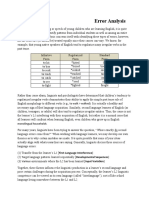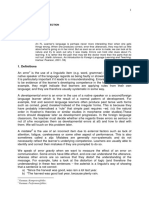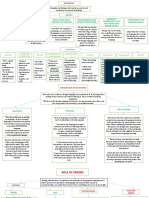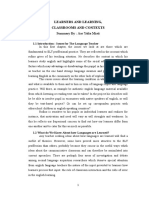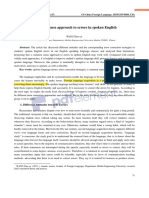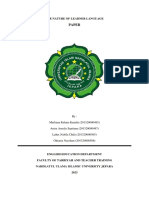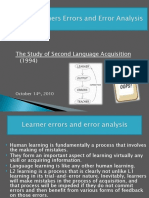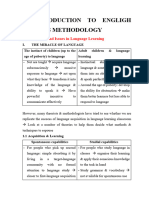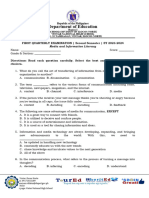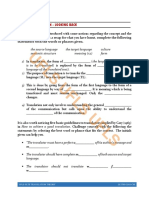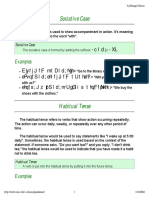P.
Level I
INTERLANGUAGE
_Developmental errors, variability. Are errors inevitable? Interference. Input.
Different contexts of acquisition and learning. Reflection on language,
correction and systematisation
This is the scene: an English lesson. The learners are
working on a problem-solving activity. They're
interested and there's good participation. However, the teacher is horritied:
nice ideas but there's a lot of Spanish going on. there are a lot of very
And a lot of errors! She thinks, "Where has all
teaching gone? They did remember to put in the my
-s for third person the whole of last week, and
now? Nothing!"
The scene must ring a bell for You. Sometimes,
no matter the amount of the effort we make to
something properly, it is as if learners processed teach
information their own way. They come up with
incorrect forms that they have never been expos
ed to. Well, error is part of human nature, isn't
it?
Teaching and learning are often indirectly relate
d; sometimes not related at all. There are things
teach which learners find too hard to learn, and we
other times they seem to pick up classroom
language which was never the goal of teaching.
Sometimes a very complex structure is adopted
used. This relates to what we said about input in and
Chapter 1.
The mind processes input according to different
parameters. One of them is that there seems to
a "natural route of development" specified by be
the target language. What does this mean? Resea
shows that learners whose mother tongues are rch
different go through very similar stages in the
development of the same target language, say Englis
h.
Incredible, isn't it? This finding has
a number of consequences. For one thing,
that the source
language has been seen to produce less impact than
it was at first thought on the target language.
What is the 'source language'? The latest language you've
learnt, or the weaker/weakest on the row.
On the row? Yes! The sequence of languages a learners is attempting to
learn.
If a learner's mother tongue is an indigenous langua
ge, or an Asian language, chances are that the
learning of English 'will' be affected by either the
specified mother tongue, or Spanish, if Spanish
already 'strong' enough to offer resistance' But if is
the learner is a Spanish speaking monolingual,
then surely Spanish will impinge upon the next
language being learnt. The 'target language’ is the
language being learnt at present. English, as you can
imagine.
What levels of language will suffer the influence
of this other language the most? Probably
pronunciation, stress and intonation. But the young
er the learners, the less noticeable the effect. At
EGB 3, there's likely to be a marked influence in this
respect.
In turn this means that the grammar of the target
language -morphology and syntax- and the
semantic aspects, will "accommodate", as it Were,
to the target language..
In turn, what does this imply? That at any stage
of this process, learners are elaborating hypotheses
on the basis of the information -the data- they get
from the environment, that is, the (English) they
hear and are taught. Sometimes these hypotheses
are incorrect or incomplete, and the result is
precisely 'errors: But errors are part of human nature
, and they give us clues as to the continuum
of development.
8 * Chapter 2 2I£GB 3 * Level T Lenguas Extranjeras
l—
�So, not only is it impossible to avoid them: they are positive indicators of the learning process. So
itis healthy to allow them and register them in a journal in order to deal with them at a later date
when the timing is appropriate.
Errors imply a number of cognitive processes at work. The correct hypotheses, the guesses, the
incomplete applications of rules, all those features constitute learer language or interlanguage.
This is not really a mixture of the source language and the target language, English. It consists of a
grammar that is in constant development, but which is systematic.
The term “interlanguage' was coined by Larry Selinker way back in 1972, in a seminal article called
precisely "Interlanguage". Selinker is at present the Head of the Centre for Interlanguage Studies,
Department of Applied Linguistics, Birkbeck College, University ot London, and is constantly
collecting data of interlanguage forms from all over the world. Your contribution might be much
appreciated.
If you would like to contact him, you might want to send him an e-mail to Lselinker Qapp-ling.
bbk.ac.uk or visit his webpage at http://www.bbkac.uk/llc/al/Larry.html
In this light, are errors the result of bad teaching? Can they be avoided? No, on the contrary. They
show that the learner's mind is working hard, and that the learning process is on its way.
So, what can a teacher do with errors? All in all, there are basically two types of strategies:
a e direct intervention, in the form of explicit correction, examples, charts on the blackboard,
among others, and
b e indirect intervention, by providing leamers with further input. This implies echoing, asking for
indirect clarification in terms of meaning, among other strategies. Basically, it also means your
reiterating the target structure detected as erroneous correctly in natural contexts of use.
What might be the effect of these strategies? As you may know very well, some of these actions
may work the miracle, and "the penny clicks" and the learner understands, and then requires
practice to consolidate this initiai learning. More practice in different contexts.
As possible activities along these lines, try to select two types of strategies, as follows:
ae anactivity thatis destined to enlarge your learners' acquisition apparatus — along the lines outlined
above;
b e an activity whose main goal is to reflect on language use, with systematisation of structures, verb
tenses and overall linguistic use.
On the scene that opened this chapter, we met a horrified teacher wondering at the misuse of Simple
Present, when apparently learners had had effective practice. One useful question we might ask is, what
kind of practice? Probably controlled practice of the type 'complete the dialogue', 'questions and
answers', 'fill in the blanks', and others. This type of practice we call “controlled' practice or manipulation,
or pre-communicative. These are some of the names that appear in textbooks.
In the problem-solving activity described, learners were interested and produced creative solutions,
but there was a lot of Spanish going on and many errors.
The activity was uncontrolled. Learners were really communicating. There was "communicative
stress" due to their motivation. The situation was very different from the types of activities listed
above, where there was control of the linguistic variable.
EGB 3 * Level 1 * Lenguas mujezaslthamuw 2e9
h"
� Interlanguage
What do we mean by 'communicative stress? To our knowledge, it's the only type of
stress that is
positive. It's the kind of willingness, of drive that pushes the learner on to wanting to find out,
to
perform, to retrieve linguistic and communicative information. A good learner, in short.
For one thing, research points to different aspects of language being acquired and learnt in different
depths. It also implies the development of different strategies to resolve communive tasks involving
different language levels, sometimes isolated, others times isolated.
This means that the contexts of performance or "discourse domains" were very different. That's why
learners' performance was different. The immediate conclusion is that learner performan
ce is
variabie. We refer to this type of phenomenon 'contextual variability'.
Variabilily in learner language is parallel to variability in native language use. In fact, we don't
talk
in the same way to a close friend, to our family or to our headteacher. We don't talk in the same
way to our family members if we're happy as when we're worried or angry.
So we see that that language is so versatile and flexible that it adapts to who we're talking to, when,
where and why, how we feel and what's going on on our minds. Why should foreign language
use
be any different?
In conclusion, we recommend to take note of how learner language correlates with the
communicative situation and its demands, and how learners adapt to it, affectively and cognitively.
You might propose two different kinds of activity, a factual; one, in which Iearners have to report
on content they have discovered, and another in which they must record their feelings
We'll come back to this soon. See you.
References
. Eubank, L Selinker & M. Sharwood Smith (eds.). The current stote of interlanguage (pp. 205-217).
John Benjamins. Philadelphia.
Selinker, L Interlanguage. International Review of, Applied Linguistics, 10, 209-31. 1972.
10 * Chapter * zlma 3 * Level Te Lenguas Extranjeras
